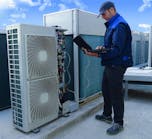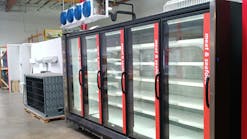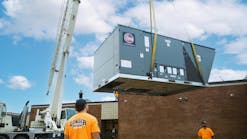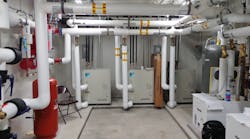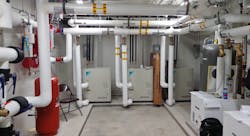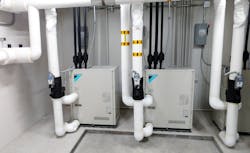CONTROLS CASE STUDY
Daikin Applied-directed Project Combines Heat Recovery, VRV and BACnet
Electrical cooperative required solutions that were efficient, easy to maintain and quiet.
Chippewa Valley Electrical Cooperative (CVEC) began building their new headquarters office in the fall of 2014. When it came time to select an HVAC system for its new facility, CVEC felt it had to lead by example. The HVAC system needed to be highly efficient, easy to maintain, quiet, comfortable and interlocked with a make-up air system using centralized controls. A variety of systems were reviewed for the project. These included traditional water source heat pumps (WSHP), water cooledVRV, and four-pipe fan coils.
After thorough analysis, a Daikin water cooled VRV-W heat recovery system with i-Touch Manager with BACnet® interface was selected. A Daikin VRV-W heat recovery system provides a highly efficient heating and cooling solution for the variety of fan coils located throughout the building’s office space. Compared to the previous office space with baseboard electric heating, the new office, with multiple fan coils, provides more zoning control and subsequent comfort. VRV-W condensers are connected directly to a closed-loop geothermal field providing additional efficiency opportunities and the ability for the VRV system to provide heat in extreme Wisconsin winters. A small, single computer equipment server room required 24-hour cooling and individual temperature control.
A Daikin VRV-W heat recovery system provides a highly efficient heating and cooling solution for the variety of fan coils located throughout the building’s office space.
Wall space for computer racks was too valuable to hang a wall unit, and using a ducted unit for only one room didn’t make sense. A single 4-Way Blow Ceiling-Suspended Cassette was installed centrally within the computer room, but not over top any computer equipment. This was a perfect application to simply attach the low-profile cassette unit to the concrete ceiling.
The VRV system’s ability to modulate condenser water flow according to the building’s heating and cooling demand.
Daikin reached out to Chippewa Valley and the mechanical engineer responsible for the design after a full year of occupancy.
“I’m convinced water cooled VRV systems are a viable alternative to traditional systems,” said Todd Armstrong of Apex Engineering. “They cost about the same to install as WSHP systems and also offer additional efficiency and maintenance benefits. Owners like the idea of being able to consolidate the compressors in one location as well. We’ve already installed three of these systems and have another in the pipeline. I was also impressed by how seamless and easy it was to integratethe equipment controls. It would have probably taken a third-party controls sub-contractor hundreds of hours to program and integrate the system. It only took Schwab Vollhaber Lubratt, along with Daikin technicians, two days to start-up the entire system.” CVEC has been very impressed with their VRV-W water cooled system.
“The power bill for the entire year, using the VRV system, was equal to one month’s heating bill with the old system,” said Russ Falkenberg, Director of IT and Member Services, CVEC.
Case study provided by Daikin Applied
